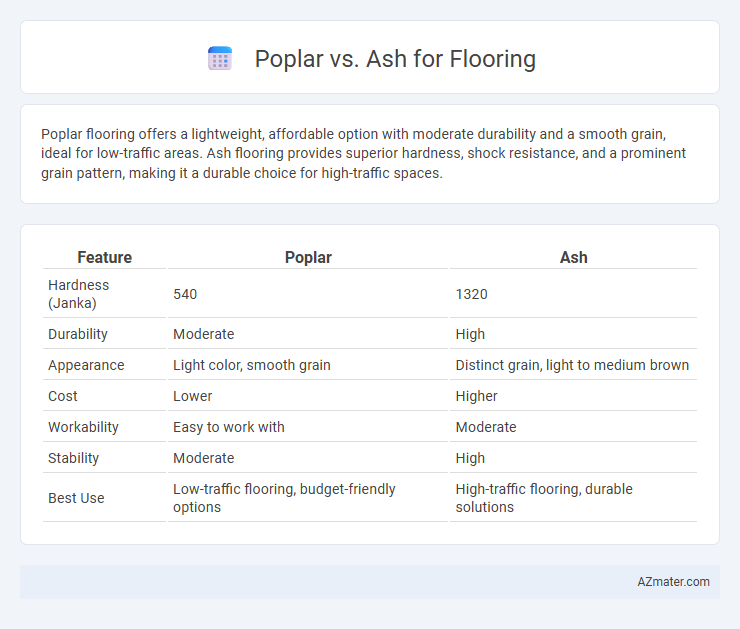Poplar flooring offers a lightweight, affordable option with moderate durability and a smooth grain, ideal for low-traffic areas. Ash flooring provides superior hardness, shock resistance, and a prominent grain pattern, making it a durable choice for high-traffic spaces.
Table of Comparison
| Feature | Poplar | Ash |
|---|---|---|
| Hardness (Janka) | 540 | 1320 |
| Durability | Moderate | High |
| Appearance | Light color, smooth grain | Distinct grain, light to medium brown |
| Cost | Lower | Higher |
| Workability | Easy to work with | Moderate |
| Stability | Moderate | High |
| Best Use | Low-traffic flooring, budget-friendly options | High-traffic flooring, durable solutions |
Introduction to Poplar and Ash Flooring
Poplar flooring is known for its light color, smooth texture, and affordability, making it a popular choice for budget-conscious homeowners seeking a subtle, natural wood appearance. Ash flooring offers greater durability with a distinctive grain pattern and light to medium brown hues, often preferred for high-traffic areas and modern interiors. Both woods provide unique aesthetic and functional benefits, with poplar excelling in ease of staining and ash favored for strength and wear resistance.
Appearance and Grain Patterns Comparison
Poplar flooring showcases a light, creamy color with subtle green or yellow hues, featuring a mostly straight, fine grain that offers a smooth and uniform appearance ideal for modern and minimalist interiors. In contrast, ash flooring presents a warm, pale to medium brown tone with prominent, distinctive open grain patterns and pronounced growth rings, delivering a more rustic and textured look that enhances traditional and farmhouse-style spaces. The choice between poplar and ash for flooring largely depends on the desired aesthetic, with poplar providing a softer, more consistent grain, while ash emphasizes bold, striking grain patterns for added visual interest.
Hardness and Durability: Poplar vs Ash
Ash flooring is significantly harder and more durable than poplar, boasting a Janka hardness rating of approximately 1,320 compared to poplar's much softer rating of around 540. This higher hardness makes ash more resistant to dents, scratches, and wear over time, ideal for high-traffic areas and long-lasting floors. Poplar's softness results in easier denting and less durability, making it better suited for light-use spaces or areas where cost-effectiveness is prioritized over toughness.
Color Variations and Finishing Options
Poplar flooring offers a wide range of color variations, typically showcasing light cream to yellowish-brown tones with occasional green or pink hues, making it versatile for modern or rustic interiors. Ash flooring provides more consistent color patterns, characterized by pale beige to light brown shades with prominent grain patterns, suitable for classic or contemporary designs. Both woods accept stains and finishes well, but poplar's softer texture allows for smoother application of paints and stains, while ash's hardness delivers a durable, polished finish ideal for high-traffic areas.
Installation Process Differences
Poplar flooring offers easier installation due to its lighter weight and softer wood grain, which allows for smoother cutting and nailing. Ash, being harder and denser, requires specialized tools and more precise handling to avoid splitting or cracking during installation. The choice between poplar and ash impacts labor time and tool requirements, influencing overall project costs and efficiency.
Maintenance and Cleaning Requirements
Poplar flooring requires minimal maintenance with regular sweeping and occasional damp mopping to prevent dirt buildup, but it is more susceptible to dents and scratches due to its softer nature. Ash flooring, being harder and denser, resists wear better and demands similar cleaning routines, though it handles moisture and stains more effectively. Both woods benefit from periodic refinishing to maintain appearance, yet ash offers greater long-term durability and ease in upkeep.
Cost Comparison: Poplar vs Ash Flooring
Poplar flooring generally costs between $3 to $5 per square foot, making it a budget-friendly option for homeowners seeking affordable hardwood. Ash flooring, priced around $5 to $8 per square foot, tends to be more expensive due to its greater durability and appealing grain pattern. Choosing between poplar and ash flooring depends on balancing upfront installation costs with long-term value and maintenance considerations.
Environmental Impact and Sustainability
Poplar flooring is highly sustainable due to its fast growth rate and ability to thrive in diverse climates, resulting in lower environmental impact from harvesting. Ash, while slower-growing than poplar, is often sourced from managed forests with responsible forestry practices that promote biodiversity and carbon sequestration. Both woods offer renewable options, but poplar's rapid renewability and lower resource demands make it a more eco-friendly choice for environmentally conscious flooring projects.
Popular Uses and Design Styles
Poplar flooring is favored for its affordability and smooth grain, making it ideal for modern and rustic design styles that emphasize simplicity and warmth. Ash flooring, known for its durability and prominent grain pattern, is commonly used in traditional and contemporary settings to create bold, statement floors with natural character. Both woods suit high-traffic areas, but Ash's hardness makes it preferable for long-lasting floors, while Poplar's softness allows for easier customization and staining.
Pros and Cons of Poplar vs Ash for Flooring
Poplar flooring offers affordability and a smooth, consistent grain but lacks hardness and durability compared to Ash, making it more prone to dents and wear. Ash flooring excels in strength and shock resistance, featuring a distinct grain pattern and lighter color ideal for high-traffic areas but typically comes at a higher cost. Choosing between Poplar and Ash depends on budget constraints, aesthetic preferences, and required floor durability.

Infographic: Poplar vs Ash for Flooring
 azmater.com
azmater.com